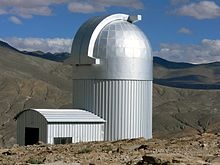India setting up world's second-largest gamma ray telescope in Ladakh
28 Jun 2014
Over the next two years, India will have the world's second-largest gamma ray telescope installed in the high altitude Hanle region in Ladakh, opening a giant window to the universe.
 The Major Atmospheric Cherenkov Experiment (MACE) Telescope, built at a cost of Rs45 crore at the state-owned Electronics Corporation of India Ltd in Hyderabad, will help scientists gain new knowledge on the origin of the universe and the cosmic rays that bombard the space.
The Major Atmospheric Cherenkov Experiment (MACE) Telescope, built at a cost of Rs45 crore at the state-owned Electronics Corporation of India Ltd in Hyderabad, will help scientists gain new knowledge on the origin of the universe and the cosmic rays that bombard the space.
The 45-metre high and 180-tonne telescope built for Bhabha Atomic Research Centre (BARC) was flagged off today at Antenna Systems Group, Electronics Corporation of India Limited (ECIL).
The telescope will be the second-largest gamma ray telescope in the world.
After becoming fully operational by early of 2016, it will improve understanding of astrophysics, fundamental physics, particle acceleration mechanisms for gamma-ray generation and spectral cut off of Pulsars.
''The telescope will be operational in Ladakh by early 2016. After we reassemble the structure there, we will have to have some scientific trials and calibrations,'' P Sudhakar, chairman and managing director of ECIL, said.
This will be the fourth gamma ray telescope in the world. The largest such telescope built by a consortium of European countries with a diameter of 28 m is currently in operation in Namibia.
''This is the second largest with a diameter of 21 m. But because it is being located in the high altitude Ladakh region, it will have the same capabilities of the one in Namibia,'' T Koul, head of Astro Sciences division at BARC, said.
The other two gama ray telescope are located in Spain and the US.
The telescope is fitted with over 1,300 specialised diamond-turned mirrors that can capture gamma rays that hit the earth's atmosphere from space more than 100 million light years away.
The rays are then captured by a 1088-pixel camera fitted at the tip of the structure.
''We can study super nova rays, pulsar energy flashes and other unidentified sources of such energy in the space,'' Koul said.
The MACE Telescope consists of a 1200 kg high resolution imaging camera weighing, for detection and characterization of the atmospheric Cherenkov events forms the focal plane instrumentation of the telescope. The structure is designed to operate in winds of speed up to 30 kmph and retain its structural integrity in the parking position in winds of speed up to 150 kmph.
More than 25 engineers from ECIL worked over a period of four years to develop the telescope. Several divisions of BARC also contributed to the development of various subsystems of MACE telescope. Indian Institute of Astrophysics, Bengaluru and Tata Institute of Fundamental Research, Mumbai are also associated with the project.
Meanwhile, astrophysicists from the Irkutsk State University in Russia have begun the construction of the world's largest gamma-ray telescope Tunka-HiSCORE.
The telescope will be constructed in Tunka Valley in Buryatia, close to Russia's border with Mongolia.
''The telescope that has no analogues in the world will register ultra-high energy particles coming from the universe,'' the University Press Service said.
The site will feature 10 optical stations and 20 stations to register charged particles, it said.
The cost of this equipment is 92 million roubles as the bulk of the expenses will be covered by a grant Irkutsk's researchers won in April. The overall cost of Tunka HiSCORE's first phase is about 200 million roubles.
The project, led by Razmik Mirzoyan, an acclaimed astrophysicist from the Max Planck Institute for Physics in Germany's Munich, involves 25 students, post graduates and researchers from the university's department of physics and the Research Institute of Applied Physics, it said.
The site is currently being run by Russian and German astrophysicists and has about 175 photo-multiplier stations hunting for Cherenkov radiation on moonless and cloudless nights.
The observatory will be expanded to include 1,000 detectors spread across at least ten square km in the next three years



.webp)



























